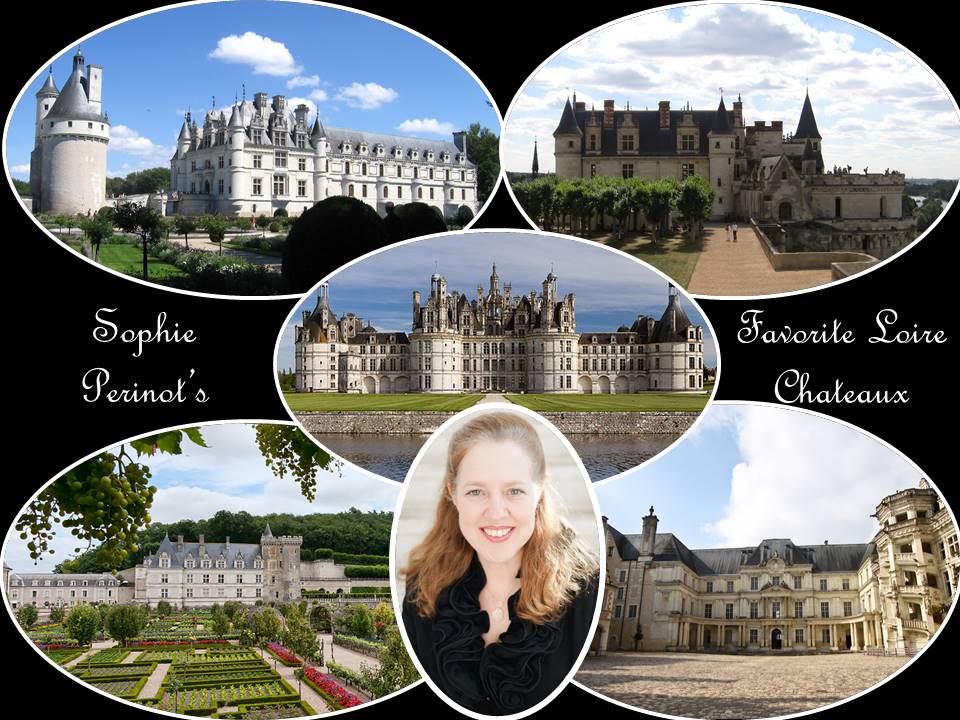Tag: Valois history
My Favorite Loire Chateaux
Did you know there are OVER THREE-HUNDRED Loire Valley Chateaux? Well it’s true. I am betting nobody has seen them all. I’ve been visiting the Loire since I was 20 (and we will not discuss how long ago that was). Here’s my personal TOP 10 FAVORITES list. Which ones have you been to? How would your list differ from mine?
1) CHENONCEAU: Call it a girlhood crush but Chenonceau—Chateaux of Diane de Poitier and Catherine de Médicis—will always top my list. Chenonceau is the most visited and photographed chateau in the Loire Valley. It is often described as ‘the ladies chateau’ as throughout its history a series of women had the most influence its design and its destiny. Besides the gracefully river-spanning gallery, the stunning gardens, Catherine’s bedchamber, and the fact that Valois history is everywhere, I particularly love that they preserved a portion of the severe black and white (colors of royal mourning) décor that King Henri III’s widow brought to the palace. Not going to lie though—her deep mourning always puzzled me because Henri (Catherine’s favorite son) is not one of my favorite people (or Kings). He was, however, good friends with his wife (who worshipped him), so I guess she had reason to be attached to him.
Given my long attachment to the chateau, I was BEYOND THRILLED when my publisher put Chenonceau on the cover of my book Médicis Daughter: A Novel of Marguerite de Valois !!!
Want a quick tour and history of this royal gem? I’ll hand the mic over to Rick Steves.
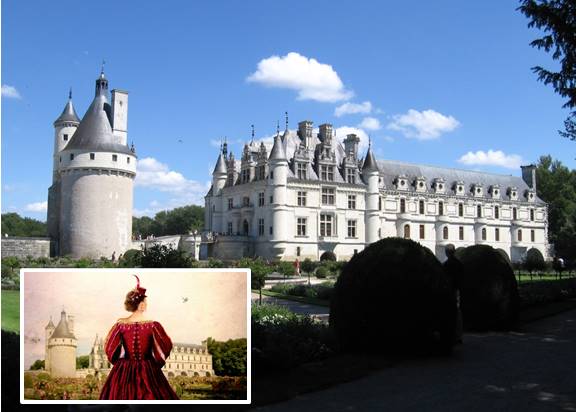
2) TIED—BLOIS and AMBOISE:
a) BLOIS: I love the split character of Blois. Built in stages around the main courtyard, this fabulous palace has a whopping 564 rooms (including 100 bedrooms) and 75 staircases. Francis I undertook a major renovation of Blois (do we see a pattern here? The man pretty much renovated all my favorites) at the behest of his wife who wanted them to spend more time at Blois and less at Amboise. When Queen Claude died Francis spent little time at Blois but his renovation gave the Chateau my favorite feature—the gorgeous Francis I spiral staircase. The Valois spent considerable time at Blois. Princess Marguerite’s wedding contract was signed here (as readers of Médicis Daughter will remember). When Margot’s brother, King Henri III, was eventually drive from Paris during the later period of the French Wars of Religion he and Catherine lived at Blois. The “Estates-General” were held there in 1576 and 1588. For those readers of Médicis Daughter who are firmly “Team Henri, Duc de Guise” this is the Chateau where he was assassinated by the royal bodyguard of Henri III (during the 1588 meeting of the “Estates”). Here is a link for the English version of the Chateau’s official website.
b) AMBOISE: When I found out that Princess Marguerite was sent to Amboise with her youngest brother during the first War of Religion I was thrilled! History was giving me the chance to set a scene—the opening scene as it turned out—of my Valois novel, Médicis Daughter, at one of my favorite Chateaux. Amboise is an absolute stunner as it towers, tall and white, above the charming city of Amboise. And once you wend your way up to it, the Chateau’s graceful interior and breathtaking views of the city, river and countryside beyond are unforgettable.
This is a palace chockfull of Valois history! King Charles VIII was the Valois monarch who spent the most time at Amboise living there daily with his wife, Anne of Brittany, until his untimely death (he left a tennis match and managed to hit his head on a door lintel, fell unconscious and died—talk about bad luck). King Francis I grew up here and later refurbished a wing in glorious renaissance style (look for his Salamander symbol). Henri II actually constructed a wing parallel to the one his father renovated—though sadly it does not exist today. He and his Queen, Catherine de Médicis, spent considerable time at Amboise.
Finally if you are fan of the short-lived King Francis II (possibly thanks to the TV series Reign) Amboise has a place in his history as well. In 1560 the 16 year old Francis was the target of an attempted kidnapping. French Protestants (allied with the Prince of Condé) felt the young King was being unduly influenced by his wife—Mary Stuart, Queen of Scotland’s—uncles, the powerful Guises. This influence was leading to the repression and persecution of France’s growing number of Protestants. In March a band of Protestants tried to remove François II from the influence of the Guises by whisking him away from the Château d’Amboise. The conspirators were caught, and quickly executed—their bodies hanged from the balcony of Chateaux Amboise as a warning to others. Perhaps not surprisingly, Chateau Amboise fell out of royal favor after this incident.
This is the link for the Chateau’s English website.
4) CHAMBORD: Big, bold and beautiful! If you like more of everything than you are going to love Chambord with its 365 fireplaces (one for every day of the year) and its Leonardo da Vinci designed double spiral staircase (the two spirals climb the three floors without ever meeting, preserving the privacy of those using one from those using the other). This big-boy was begun—but never finished despite 28 years of construction—by King Francis I as a hunting lodge. His salamander emblem and the motto: ” Nutrisco et Extinguo” (until it fills the whole world) are seen many times in the Chateau. You can also find his son King Henri II’s mark—just look for the motto “Nec pluribus impar” (alone against all). The massive château is composed of a central keep with four immense towers at the corners, all very prettily reflected in a decorative moat (defensive moats being “so very medieval” aka yesterday). And because the motto of this place is clearly “big is better” it sits on over 12,000 acres.
The Chateau has a gorgeous website. Check it out!
5) VILLANDRY: Go for the beautiful formal gardens, they are magical. The current Chateau was built in the 16th century by Jean Le Breton, France’s Controller-General for War under King Francis I. It remained in the Breton family for more than 200 years. Villandry is not a royal Chateau but certainly worthy of royalty.
6) CHINON: This tribute to the middle-ages, built from the 12th century on a rocky outcrop above the Vienne River, is closely associated with French history from the 12th to the 15th centuries. This is where Joan of Arc claimed to have heard heavenly voices when she met the French King. Really more of a Hundred Years War era Chateau (not that there is anything wrong with that!) there is no Valois connection to Chinon except for the fact that at the very start of the French Wars of Religion (1562) Chinon was briefly in the hands of Protestant forces.
7) AZAY-LE-RIDEAU: Considered one of the foremost examples of early French renaissance architecture and set on a picturesque island in the middle of the Indre river, is it any wonder Azey-le-Rideau is one of the most visited of the Loire Chateaux? Although you will find the salamander and ermine of Francis I and his wife, Claude of France, carved into the architecture here, this was never a royal chateau (the nobleman who built it merely included the royal devices to honor his monarch—clever man).
8) SULLY-SUR-LOIRE: Clearly I have a thing going for some of the Protestant gentlemen who served King Henri IV of France (the first Bourbon King). This equally powerful and beautiful collection of white towers ringed and reflected in water is one of two Chateaux that make my favorites list as a result of their owners (see also Saumur). Sully-sur-Loire was constructed in the 15th century and was intended as both a fortification to defend a nearby bridge over the Loire River and a luxury residence. I visited the castle primarily because it was purchased in 1602 by Maximilien de Béthune, Duc de Sully. Maximilien was extraordinary. As a young man he escaped the St. Bartholomew’s Day Massacre by his wits and subsequently presented himself to fellow survivor King Henri of Navarre. From that time on he and the King of Navarre were close. When Henri ascended to the French throne as Henri IV of France Maximilien was the King’s Superintendent of Finance helping to bring order and stability to a French economy blighted by years of religious war. The Duc made substantial changes to Sully-sur-Loire and it remained in his family until 1962. Maximilien’s tenure is still evident in the structure and, as my children can attest and much to their eternal embarrassment, I broke down in tears when I found his decorative initials incorporated in the dining room décor.
Here is a lovely—if silent—video aerial look at Sully-sur-Loire.
9) SAUMUR: overlooking the confluence of the Loire and the Thouet Rivers this striking Chateau was built in the 10th century making it one of France’s oldest castles. Saumur (as it looked in 1410 when it was home to the Duc d’Anjou) was depicted in the Très Riches Heures du Duc de Berry. I have a massive crush on the nobleman that King Henri IV (“the Great”) of France gave Saumur to in 1589— Philippe de Mornay, the seigneur du Plessis Marly, often called “The Protestant Pope”—but more about that another time 😉
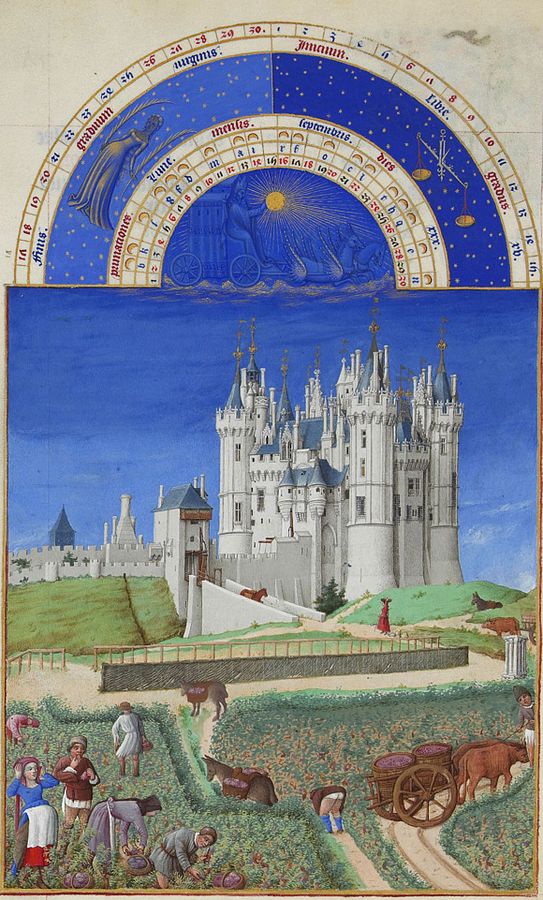
10) CHEVERNY: because everything can be about the medieval and renaissance ( I KNOW, I know, it is surprising to hear me say so). Variety is the spice of life! Cheverny is pure 17th century—very Louis XIII style with its emphasis on symmetry. The fact that is remained largely as it was built may have a lot to do with the fact that the Hurault family has owned Cheverny for 6 centuries—clearly they are a family that values tradition.
A Little Invasion and some Big Questions . . .
In mid-July of 1572 a French Huguenot nobleman, the Seigneur de Genlis, invaded Netherlands from France with 4,000 infantry and slightly less than 1,000 Calvary. It went badly. Don Frederic of Toledo routed the Seigneur and his troops at Quiévrain, and not two hundred Frenchmen survived (those who survived the battle proper where quickly slaughtered by local peasants). Gossip and fallout at the French Court was immediate.
A good number of courtiers and foreign figures (for example the Venetian ambassador) were sure Genlis had been sent by Admiral Coligny with the King’s knowledge. Others avowed, adamantly, that the Seigneur had gone without the knowledge or permission of either the King or the Admiral.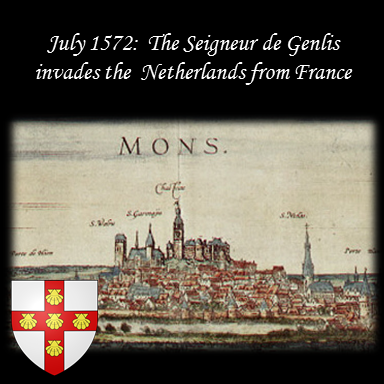
Frankly, and after years researching the Valois Court in this era, it is impossible for me to believe that the King did not at least know of Seigneur de Genlis’ plan in advance, whether or not he tacitly approved it, if for no other reason than the planned invasion was a very open secret at French Court. So much so that Spain caught wind of it making for an easy interception of the French near mons. Additionally, a letter evidencing Charles complicity found on Genlis when was taken prisoner.
Yet confronted with the invasions catastrophic failure, Charles denied that he sanctioned the expedition and congratulated Philip II on his victory. This represented more than a desperate effort to distance himself from a plan run amok. His actions were at his mother Catherine de Médicis’ behest and she also demanded that he declare publicly that his subjects had disobeyed his orders in going to Flanders. All of this suborning of what was basically perjury was part of a larger struggle between the Queen Mother and Admiral Coligny for the role of chief-influencer over Charles. War with Spain was on the table and while Coligny pressed for it, Catherine was against it.
Less than two months later the winner and loser of this struggle would become painfully and bloodily clear.
Happy Birthday Queen Catherine de Medicis
Today marks the 497th birthday of Catherine de Médicis, Queen of France and a woman with many detractors. 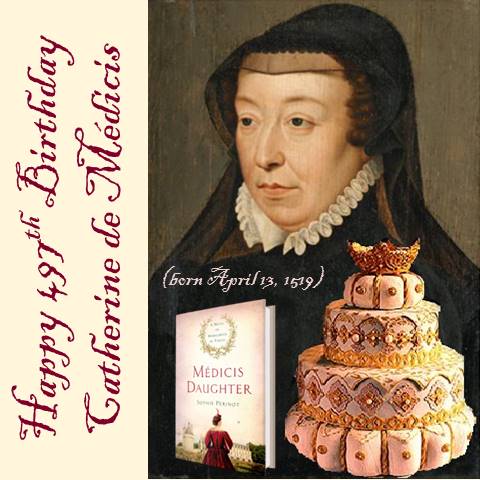
Catherine did not begin her life with much to celebrate. Although she had illustrious parents—her Mother (Madeleine de La Tour d’Auvergne, Comtesse de Boulogne) was a French princess of royal blood and father was Lorenzo de’ Medici—both were dead within a MONTH of her birth (and that was incidentally only about a year after their marriage). After they were gone, and because of her mother’s connection to the French crown, King Francis I claimed the right to raise the orphaned Catherine. But Pope Leo told the French King to pound salt. His Holiness wasn’t all that caring—he just viewed Catherine, Lorenzo’s legitimate heiress, as a useful pawn. Later in life, Catherine would remark that her eventual father-in-law, Francis I, was more of a father to her than His Holiness had ever been.
When in the fall of 1533, at age 14, Catherine was shipped off to France to marry the future Henri II her new husband was not yet even Dauphin—merely a second son. And he preferred another woman, his already established Mistress Diane de Poitier. Catherine’s new country wasn’t impressed with Catherine either. A report from one of the Venetian ambassadors declared that “all of France” disapproved of the marriage. So Catherine’s early experiences of rejection continued.
Yet from these inauspicious beginnings arose one of the 16th century’s true female power-players. A Queen who, left widowed with a large family, managed to keep her husband’s line securely on the throne during a time of nearly continual war. A woman who “managed” a series of boy kings—arguably to their detriment and France’s. Historians may disagree strongly on both the content and efficacy of Catherine’s policies with respect to the Wars of Religion—and just about everything else—but no one would disagree that she was a key influence in the post-Henri II Valois era and as such she deserves as much credit for what went right in that period as she does blame for what went wrong.
Farewell to a Princess . . .
On this day four-hundred-and-one years ago, Marguerite de Valois, heroine of Médicis Daughter, died. 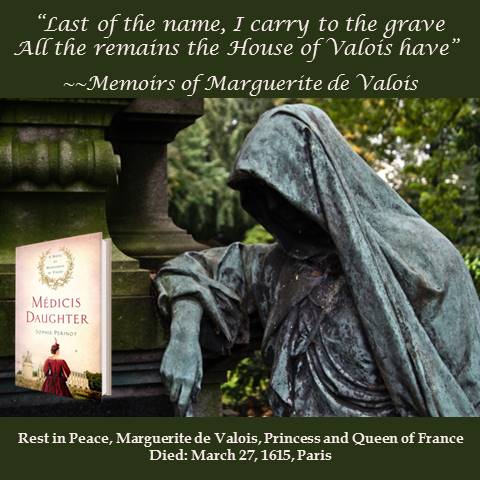 The last of the Valois was initially buried at the Basilica of St Denis, traditional resting place of French Royals and the place where both her parents and her brothers lay. Unfortunately, the French Revolution showed no respect for the dead. So the bodies of the Bourbon and Valois monarchs were removed from the Basilica to “celebrate” the October 1793 execution of Marie Antoinette, and given ignominious trench burials. The monument that marked Marguerite’s grave was destroyed. Today the location of Marguerite’s tomb is not on maps of burial places at St. Denis, although her brother Henri III and her parents Catherine de Médicis and Henri II are still listed.
The last of the Valois was initially buried at the Basilica of St Denis, traditional resting place of French Royals and the place where both her parents and her brothers lay. Unfortunately, the French Revolution showed no respect for the dead. So the bodies of the Bourbon and Valois monarchs were removed from the Basilica to “celebrate” the October 1793 execution of Marie Antoinette, and given ignominious trench burials. The monument that marked Marguerite’s grave was destroyed. Today the location of Marguerite’s tomb is not on maps of burial places at St. Denis, although her brother Henri III and her parents Catherine de Médicis and Henri II are still listed.
Click here for more on the tragic revolutionary “Profanation at Saint Denis.”
The Massacre of Vassy
Today is a bloody anniversary.
Four-hundred and fifty-four years ago, on March 1, 1562 a massacre that began the first of France’s eight Wars of Religion occurred: the Massacre of Vassy. Just six weeks earlier the Crown—young King Charles IX was on the throne and his mother Catherine de Médicis was regent—had signed the “Edict of January,” granting Protestants within French borders certain rights of conscience. The powerful Guise family—uber Catholic and thinking they knew better—wanted that edict rescinded. The Duc de Guise (Francis, father of the Duc in my latest novel, Médicis Daughter) saw a chance to make that happen when, while traveling to his estates, he stopped in Vassy to hear Mass and happened upon a group of French Huguenot civilians worshiping in barn near the Catholic Church. Francis and his men attacked. Seventy-four members of the Protestant congregation were slain, and more than one-hundred injured. Both numbers included women and children.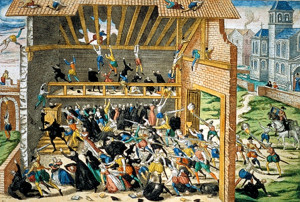
Not surprisingly, the massacre resulted in a newly militant attitude among French Protestants. In the wake of Vassy the national synod of the reformed church appealed to the Prince de Condé to become “Protector of the Churches,” and he and those in his sway accepted the task. This marked a switch in church leadership away from various pastors and towards “noble protectors.” It also set the stage for decades of military clashes in the name of religion.
Hoping to cool matters down and in response to French Protestant calls for “justice” Catherine de Médicis appointed the Cardinal de Bourbon governor of Paris. The Cardinal in turn immediately ordered both the Duc de Guise and the Protestant Prince de Condé to leave the city, but Guise refused (Condé left as ordered). Catherine knew right then if she hadn’t known before that the Guises were going to be a serious thorn in her side.
